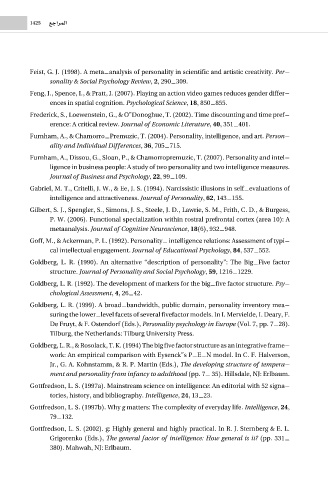Page 1426 - theCambridgehandbookofintelligence1
P. 1426
1425 ™LGôªdG
Feist, G. J. (1998). A meta-analysis of personality in scientific and artistic creativity. Per-
sonality & Social Psychology Review, 2, 290-309.
Feng, J., Spence, I., & Pratt, J. (2007). Playing an action video games reduces gender differ-
ences in spatial cognition. Psychological Science, 18, 850-855.
Frederick, S., Loewenstein, G., & O Donoghue, T. (2002). Time discounting and time pref-
erence: A critical review. Journal of Economic Literature, 40, 351-401.
Furnham, A., & Chamorro-Premuzic, T. (2004). Personality, intelligence, and art. Person-
ality and Individual Differences, 36, 705-715.
Furnham, A., Dissou, G., Sloan, P., & Chamorropremuzic, T. (2007). Personality and intel-
ligence in business people: A study of two personality and two intelligence measures.
Journal of Business and Psychology, 22, 99-109.
Gabriel, M. T., Critelli, J. W., & Ee, J. S. (1994). Narcissistic illusions in self-evaluations of
intelligence and attractiveness. Journal of Personality, 62, 143-155.
Gilbert, S. J., Spengler, S., Simons, J. S., Steele, J. D., Lawrie, S. M., Frith, C. D., & Burgess,
P. W. (2006). Functional specialization within rostral prefrontal cortex (area 10): A
metaanalysis. Journal of Cognitive Neuroscience, 18(6), 932-948.
Goff, M., & Ackerman, P. L. (1992). Personality- intelligence relations: Assessment of typi-
cal intellectual engagement. Journal of Educational Psychology, 84, 537-552.
Goldberg, L. R. (1990). An alternative “description of personality”: The Big-Five factor
structure. Journal of Personality and Social Psychology, 59, 1216-1229.
Goldberg, L. R. (1992). The development of markers for the big-five factor structure. Psy-
chological Assessment, 4, 26-42.
Goldberg, L. R. (1999). A broad-bandwidth, public domain, personality inventory mea-
suring the lower-level facets of several fivefactor models. In I. Mervielde, I. Deary, F.
De Fruyt, & F. Ostendorf (Eds.), Personality psychology in Europe (Vol. 7, pp. 7-28).
Tilburg, the Netherlands: Tilburg University Press.
Goldberg, L. R., & Rosolack, T. K. (1994) The big five factor structure as an integrative frame-
work: An empirical comparison with Eysenck s P-E-N model. In C. F. Halverson,
Jr., G. A. Kohnstamm, & R. P. Martin (Eds.), The developing structure of tempera-
ment and personality from infancy to adulthood (pp. 7- 35). Hillsdale, NJ: Erlbaum.
Gottfredson, L. S. (1997a). Mainstream science on intelligence: An editorial with 52 signa-
tories, history, and bibliography. Intelligence, 24, 13-23.
Gottfredson, L. S. (1997b). Why g matters: The complexity of everyday life. Intelligence, 24,
79-132.
Gottfredson, L. S. (2002). g: Highly general and highly practical. In R. J. Sternberg & E. L.
Grigorenko (Eds.), The general factor of intelligence: How general is it? (pp. 331-
380). Mahwah, NJ: Erlbaum.

